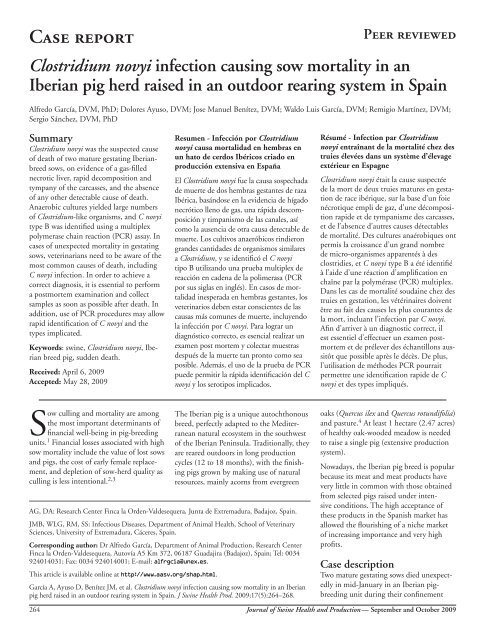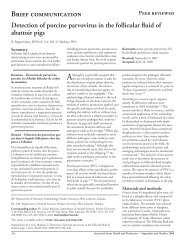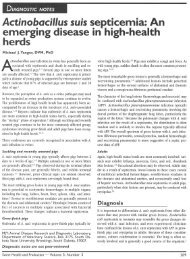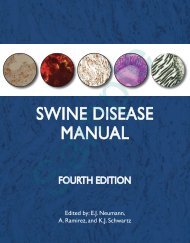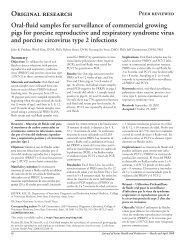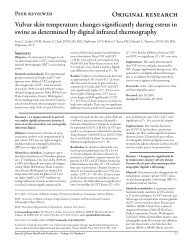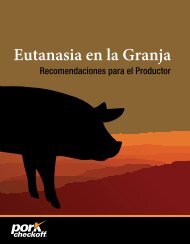Clostridium novyi infection causing sow mortality in an - American ...
Clostridium novyi infection causing sow mortality in an - American ...
Clostridium novyi infection causing sow mortality in an - American ...
Create successful ePaper yourself
Turn your PDF publications into a flip-book with our unique Google optimized e-Paper software.
Case report<br />
264<br />
Peer reviewed<br />
<strong>Clostridium</strong> <strong>novyi</strong> <strong><strong>in</strong>fection</strong> <strong>caus<strong>in</strong>g</strong> <strong>sow</strong> <strong>mortality</strong> <strong>in</strong> <strong>an</strong><br />
Iberi<strong>an</strong> pig herd raised <strong>in</strong> <strong>an</strong> outdoor rear<strong>in</strong>g system <strong>in</strong> Spa<strong>in</strong><br />
Alfredo García, DVM, PhD; Dolores Ayuso, DVM; Jose M<strong>an</strong>uel Benítez, DVM; Waldo Luis García, DVM; Remigio Martínez, DVM;<br />
Sergio Sánchez, DVM, PhD<br />
Summary<br />
<strong>Clostridium</strong> <strong>novyi</strong> was the suspected cause<br />
of death of two mature gestat<strong>in</strong>g Iberi<strong>an</strong>breed<br />
<strong>sow</strong>s, on evidence of a gas-filled<br />
necrotic liver, rapid decomposition <strong>an</strong>d<br />
tymp<strong>an</strong>y of the carcasses, <strong>an</strong>d the absence<br />
of <strong>an</strong>y other detectable cause of death.<br />
Anaerobic cultures yielded large numbers<br />
of <strong>Clostridium</strong>-like org<strong>an</strong>isms, <strong>an</strong>d C <strong>novyi</strong><br />
type B was identified us<strong>in</strong>g a multiplex<br />
polymerase cha<strong>in</strong> reaction (PCR) assay. In<br />
cases of unexpected <strong>mortality</strong> <strong>in</strong> gestat<strong>in</strong>g<br />
<strong>sow</strong>s, veter<strong>in</strong>ari<strong>an</strong>s need to be aware of the<br />
most common causes of death, <strong>in</strong>clud<strong>in</strong>g<br />
C <strong>novyi</strong> <strong><strong>in</strong>fection</strong>. In order to achieve a<br />
correct diagnosis, it is essential to perform<br />
a postmortem exam<strong>in</strong>ation <strong>an</strong>d collect<br />
samples as soon as possible after death. In<br />
addition, use of PCR procedures may allow<br />
rapid identification of C <strong>novyi</strong> <strong>an</strong>d the<br />
types implicated.<br />
Keywords: sw<strong>in</strong>e, <strong>Clostridium</strong> <strong>novyi</strong>, Iberi<strong>an</strong><br />
breed pig, sudden death.<br />
Received: April 6, 2009<br />
Accepted: May 28, 2009<br />
Sow cull<strong>in</strong>g <strong>an</strong>d <strong>mortality</strong> are among<br />
the most import<strong>an</strong>t determ<strong>in</strong><strong>an</strong>ts of<br />
f<strong>in</strong><strong>an</strong>cial well-be<strong>in</strong>g <strong>in</strong> pig-breed<strong>in</strong>g<br />
units. 1 F<strong>in</strong><strong>an</strong>cial losses associated with high<br />
<strong>sow</strong> <strong>mortality</strong> <strong>in</strong>clude the value of lost <strong>sow</strong>s<br />
<strong>an</strong>d pigs, the cost of early female replacement,<br />
<strong>an</strong>d depletion of <strong>sow</strong>-herd quality as<br />
cull<strong>in</strong>g is less <strong>in</strong>tentional. 2,3<br />
Resumen - Infección por <strong>Clostridium</strong><br />
<strong>novyi</strong> causa mortalidad en hembras en<br />
un hato de cerdos Ibéricos criado en<br />
producción extensiva en España<br />
El <strong>Clostridium</strong> <strong>novyi</strong> fue la causa sospechada<br />
de muerte de dos hembras gest<strong>an</strong>tes de raza<br />
Ibérica, basándose en la evidencia de hígado<br />
necrótico lleno de gas, una rápida descomposición<br />
y timp<strong>an</strong>ismo de las c<strong>an</strong>ales, así<br />
como la ausencia de otra causa detectable de<br />
muerte. Los cultivos <strong>an</strong>aeróbicos r<strong>in</strong>dieron<br />
gr<strong>an</strong>des c<strong>an</strong>tidades de org<strong>an</strong>ismos similares<br />
a <strong>Clostridium</strong>, y se identificó el C <strong>novyi</strong><br />
tipo B utiliz<strong>an</strong>do una prueba multiplex de<br />
reacción en cadena de la polimerasa (PCR<br />
por sus siglas en <strong>in</strong>glés). En casos de mortalidad<br />
<strong>in</strong>esperada en hembras gest<strong>an</strong>tes, los<br />
veter<strong>in</strong>arios deben estar conscientes de las<br />
causas más comunes de muerte, <strong>in</strong>cluyendo<br />
la <strong>in</strong>fección por C <strong>novyi</strong>. Para lograr un<br />
diagnóstico correcto, es esencial realizar un<br />
examen post mortem y colectar muestras<br />
después de la muerte t<strong>an</strong> pronto como sea<br />
posible. Además, el uso de la prueba de PCR<br />
puede permitir la rápida identificación del C<br />
<strong>novyi</strong> y los serotipos implicados.<br />
The Iberi<strong>an</strong> pig is a unique autochthonous<br />
breed, perfectly adapted to the Mediterr<strong>an</strong>e<strong>an</strong><br />
natural ecosystem <strong>in</strong> the southwest<br />
of the Iberi<strong>an</strong> Pen<strong>in</strong>sula. Traditionally, they<br />
are reared outdoors <strong>in</strong> long production<br />
cycles (12 to 18 months), with the f<strong>in</strong>ish<strong>in</strong>g<br />
pigs grown by mak<strong>in</strong>g use of natural<br />
resources, ma<strong>in</strong>ly acorns from evergreen<br />
AG, DA: Research Center F<strong>in</strong>ca la Orden-Valdesequera, Junta de Extremadura, Badajoz, Spa<strong>in</strong>.<br />
JMB, WLG, RM, SS: Infectious Diseases, Department of Animal Health, School of Veter<strong>in</strong>ary<br />
Sciences, University of Extremadura, Cáceres, Spa<strong>in</strong>.<br />
Correspond<strong>in</strong>g author: Dr Alfredo García, Department of Animal Production, Research Center<br />
F<strong>in</strong>ca la Orden-Valdesequera, Autovía A5 Km 372, 06187 Guadajira (Badajoz), Spa<strong>in</strong>; Tel: 0034<br />
924014031; Fax: 0034 924014001; E-mail: alfrgcia@unex.es.<br />
This article is available onl<strong>in</strong>e at http://www.aasv.org/shap.html.<br />
García A, Ayuso D, Benítez JM, et al. <strong>Clostridium</strong> <strong>novyi</strong> <strong><strong>in</strong>fection</strong> <strong>caus<strong>in</strong>g</strong> <strong>sow</strong> <strong>mortality</strong> <strong>in</strong> <strong>an</strong> Iberi<strong>an</strong><br />
pig herd raised <strong>in</strong> <strong>an</strong> outdoor rear<strong>in</strong>g system <strong>in</strong> Spa<strong>in</strong>. J Sw<strong>in</strong>e Health Prod. 2009;17(5):264–268.<br />
Résumé - Infection par <strong>Clostridium</strong><br />
<strong>novyi</strong> entraîn<strong>an</strong>t de la mortalité chez des<br />
truies élevées d<strong>an</strong>s un système d’élevage<br />
extérieur en Espagne<br />
<strong>Clostridium</strong> <strong>novyi</strong> était la cause suspectée<br />
de la mort de deux truies matures en gestation<br />
de race ibérique, sur la base d’un foie<br />
nécrotique empli de gaz, d’une décomposition<br />
rapide et de tymp<strong>an</strong>isme des carcasses,<br />
et de l’absence d’autres causes détectables<br />
de mortalité. Des cultures <strong>an</strong>aérobiques ont<br />
permis la croiss<strong>an</strong>ce d’un gr<strong>an</strong>d nombre<br />
de micro-org<strong>an</strong>ismes apparentés à des<br />
clostridies, et C <strong>novyi</strong> type B a été identifié<br />
à l’aide d’une réaction d’amplification en<br />
chaîne par la polymérase (PCR) multiplex.<br />
D<strong>an</strong>s les cas de mortalité souda<strong>in</strong>e chez des<br />
truies en gestation, les vétér<strong>in</strong>aires doivent<br />
être au fait des causes les plus cour<strong>an</strong>tes de<br />
la mort, <strong>in</strong>clu<strong>an</strong>t l’<strong><strong>in</strong>fection</strong> par C <strong>novyi</strong>.<br />
Af<strong>in</strong> d’arriver à un diagnostic correct, il<br />
est essentiel d’effectuer un examen postmortem<br />
et de prélever des éch<strong>an</strong>tillons aussitôt<br />
que possible après le décès. De plus,<br />
l’utilisation de méthodes PCR pourrait<br />
permettre une identification rapide de C<br />
<strong>novyi</strong> et des types impliqués.<br />
oaks (Quercus ilex <strong>an</strong>d Quercus rotundifolia)<br />
<strong>an</strong>d pasture. 4 At least 1 hectare (2.47 acres)<br />
of healthy oak-wooded meadow is needed<br />
to raise a s<strong>in</strong>gle pig (extensive production<br />
system).<br />
Nowadays, the Iberi<strong>an</strong> pig breed is popular<br />
because its meat <strong>an</strong>d meat products have<br />
very little <strong>in</strong> common with those obta<strong>in</strong>ed<br />
from selected pigs raised under <strong>in</strong>tensive<br />
conditions. The high accept<strong>an</strong>ce of<br />
these products <strong>in</strong> the Sp<strong>an</strong>ish market has<br />
allowed the flourish<strong>in</strong>g of a niche market<br />
of <strong>in</strong>creas<strong>in</strong>g import<strong>an</strong>ce <strong>an</strong>d very high<br />
profits.<br />
Case description<br />
Two mature gestat<strong>in</strong>g <strong>sow</strong>s died unexpectedly<br />
<strong>in</strong> mid-J<strong>an</strong>uary <strong>in</strong> <strong>an</strong> Iberi<strong>an</strong> pigbreed<strong>in</strong>g<br />
unit dur<strong>in</strong>g their conf<strong>in</strong>ement<br />
Journal of Sw<strong>in</strong>e Health <strong>an</strong>d Production — September <strong>an</strong>d October 2009
Figure 1: The abdom<strong>in</strong>al cavity of a mature gestat<strong>in</strong>g Iberi<strong>an</strong> breed <strong>sow</strong> at necropsy. A: Full stomach <strong>an</strong>d gas bubbles <strong>in</strong><br />
the liver; B: The liver uniformly <strong>in</strong>filtrated with gas bubbles, present<strong>in</strong>g a spongy appear<strong>an</strong>ce on the cut surface, probably<br />
the most dist<strong>in</strong>guish<strong>in</strong>g feature of sudden death <strong>in</strong> <strong>sow</strong>s caused by <strong>Clostridium</strong> <strong>novyi</strong>.<br />
A B<br />
<strong>in</strong> farrow<strong>in</strong>g crates. At present, on m<strong>an</strong>y<br />
Iberi<strong>an</strong> pig farms, traditional outdoor <strong>sow</strong><br />
gestation is followed by <strong>in</strong>door farrow<strong>in</strong>g<br />
<strong>in</strong> modern premises (semi-extensive m<strong>an</strong>agement).<br />
These build<strong>in</strong>gs are equipped<br />
with slatted floor<strong>in</strong>g <strong>an</strong>d natural ventilation.<br />
The case farm had 160 <strong>sow</strong>s fed a<br />
commercial feed <strong>an</strong>d with access to the<br />
natural meadowl<strong>an</strong>d resources of pasture<br />
<strong>an</strong>d acorns. Sows farrowed twice a year <strong>an</strong>d<br />
pregn<strong>an</strong>t <strong>sow</strong>s were conf<strong>in</strong>ed <strong>in</strong> farrow<strong>in</strong>g<br />
crates 1 week before giv<strong>in</strong>g birth.<br />
Although postmortem exam<strong>in</strong>ations were<br />
performed only 2 or 3 hours after the death<br />
of the <strong>sow</strong>s <strong>an</strong>d ambient temperature was<br />
approximately 7˚C, the carcasses were<br />
grossly distended <strong>an</strong>d there was purple<br />
discoloration of the sk<strong>in</strong>. Necropsy f<strong>in</strong>d<strong>in</strong>gs<br />
revealed generalized subcut<strong>an</strong>eous<br />
edema, a foul odor when the carcass was<br />
opened, enlarged <strong>an</strong>d congested lymph<br />
nodes, bloodsta<strong>in</strong>ed fluid <strong>in</strong> pleural,<br />
pericardial, <strong>an</strong>d peritoneal cavities, serosal<br />
hemorrhages, <strong>an</strong>d enlarged spleen. In each<br />
case, the stomach was full, the lungs were<br />
congested, <strong>an</strong>d the liver was enlarged, friable,<br />
<strong>an</strong>d dark, with gas bubbles uniformly<br />
<strong>in</strong>filtrated, thereby present<strong>in</strong>g a spongy<br />
appear<strong>an</strong>ce on the cut surface (Figure 1).<br />
Necropsy samples were submitted to the<br />
School of Veter<strong>in</strong>ary Sciences at the University<br />
of Extremadura (Cáceres, Spa<strong>in</strong>)<br />
for exam<strong>in</strong>ation of smears, culture, histopathology<br />
exam<strong>in</strong>ation, <strong>an</strong>d fecal flotation<br />
<strong>an</strong>d sedimentation assays.<br />
Journal of Sw<strong>in</strong>e Health <strong>an</strong>d Production — Volume 17, Number 5<br />
Histopathological exam<strong>in</strong>ation of the liver<br />
of one <strong>sow</strong> revealed <strong>in</strong>trahepatic spherical<br />
non-sta<strong>in</strong><strong>in</strong>g cavities (gas bubbles) (Figure<br />
2) <strong>an</strong>d moderate multifocal lymphohistocytic<br />
hepatitis with hepatocellular degeneration<br />
<strong>an</strong>d necrosis.<br />
Large numbers of gram-positive rods were<br />
observed <strong>in</strong> Gram-sta<strong>in</strong>ed smears from<br />
the heart, lungs, kidneys, spleen, <strong>an</strong>d<br />
liver of each <strong>sow</strong> (Figure 3). Anaerobic<br />
cultures yielded large number of <strong>Clostridium</strong>-like<br />
org<strong>an</strong>isms. To make a rapid<br />
identification of pathogenic clostridia,<br />
the multiplex polymerase cha<strong>in</strong> reaction<br />
(PCR) procedure described by Sasaki et<br />
al 5 was performed. A BLAST homology<br />
Figure 2: Histopathology section of the liver of <strong>an</strong> Iberi<strong>an</strong> <strong>sow</strong> sta<strong>in</strong>ed with<br />
hematoxil<strong>in</strong> <strong>an</strong>d eos<strong>in</strong> show<strong>in</strong>g hepatocellular degeneration <strong>an</strong>d <strong>in</strong>trahepatic<br />
spherical non-sta<strong>in</strong><strong>in</strong>g cavities (gas bubbles) associated with <strong>Clostridium</strong> <strong>novyi</strong><br />
<strong><strong>in</strong>fection</strong> (magnification ×100).<br />
265
266<br />
Figure 3: Smears from the liver of <strong>an</strong> Iberi<strong>an</strong> <strong>sow</strong> that died of <strong>Clostridium</strong> <strong>novyi</strong><br />
<strong><strong>in</strong>fection</strong>, show<strong>in</strong>g large gram-positive rods with oval to cyl<strong>in</strong>drical subterm<strong>in</strong>al<br />
spores (magnification ×1000).<br />
Figure 4: Gel electrophoresis (2% agarose gel sta<strong>in</strong>ed with ethidium bromide)<br />
show<strong>in</strong>g a species-specific 427-pb b<strong>an</strong>d identify<strong>in</strong>g <strong>Clostridium</strong> <strong>novyi</strong> type B.<br />
The b<strong>an</strong>d was amplified us<strong>in</strong>g the multiplex polymerase cha<strong>in</strong> reaction system<br />
described by Sasaki et al. 5 L<strong>an</strong>es 1 <strong>an</strong>d 6: molecular weight marker ladder 1 kb<br />
(Biol<strong>in</strong>e GmbH, Luckenwalde, Germ<strong>an</strong>y); l<strong>an</strong>es 2 to 5, PCR amplification products<br />
from duplicate positive cultures from the livers of two Iberi<strong>an</strong> <strong>sow</strong>s that<br />
died of C <strong>novyi</strong> <strong><strong>in</strong>fection</strong>.<br />
search (program available at www.ncbi.nlm.<br />
nih.gov/BLAST) revealed that the 427-bp<br />
nucleotide sequence of the amplified<br />
product (Figure 4) matched the partial<br />
flagell<strong>in</strong> (fliC) gene of <strong>Clostridium</strong> <strong>novyi</strong><br />
type B ATCC 25758 (DDBJ accession no.<br />
AB058936) (Figure 5).<br />
Discussion<br />
<strong>Clostridium</strong> <strong>novyi</strong> is <strong>an</strong> <strong>an</strong>aerobic, sporeform<strong>in</strong>g,<br />
gram-positive rod that varies <strong>in</strong><br />
size. 6 The org<strong>an</strong>ism produces highly potent<br />
exotox<strong>in</strong>s (A to D) 7 of which the lethal,<br />
necrotiz<strong>in</strong>g alpha tox<strong>in</strong> is considered to be<br />
the pr<strong>in</strong>cipal tox<strong>in</strong> of the type B stra<strong>in</strong> <strong>in</strong><br />
pigs. 8 This tox<strong>in</strong> causes necrosis, <strong>in</strong>creases<br />
permeability of the cell barrier, <strong>an</strong>d disrupts<br />
<strong>in</strong>tercellular junctions. 6,9,10<br />
<strong>Clostridium</strong> <strong>novyi</strong> is the causative agent<br />
responsible for gas g<strong>an</strong>grene <strong>in</strong> hum<strong>an</strong>s <strong>an</strong>d<br />
<strong>in</strong>fectious necrotic hepatitis (black disease)<br />
<strong>in</strong> sheep, cattle, goats, <strong>an</strong>d horses. 7 Both<br />
C <strong>novyi</strong> types A <strong>an</strong>d B have been isolated<br />
from reported cases of sudden death <strong>in</strong><br />
<strong>sow</strong>s. 7,8<br />
Although C <strong>novyi</strong> <strong><strong>in</strong>fection</strong>s are unusual <strong>in</strong><br />
pigs, 8 cases of sudden death <strong>in</strong> <strong>sow</strong>s have<br />
been reported <strong>in</strong> <strong>in</strong>tensive sw<strong>in</strong>e-breed<strong>in</strong>g<br />
units <strong>in</strong> Europe 7,11 <strong>an</strong>d <strong>in</strong> outdoor pig units<br />
<strong>in</strong> eastern Europe. 12,13 Nevertheless, to our<br />
knowledge, <strong>mortality</strong> of <strong>sow</strong>s caused by C<br />
<strong>novyi</strong> has not been reported <strong>in</strong> Iberi<strong>an</strong> pigs<br />
reared under extensive or semi-extensive<br />
conditions, <strong>an</strong> import<strong>an</strong>t livestock subsector<br />
<strong>in</strong> the southwest of the Iberi<strong>an</strong> Pen<strong>in</strong>sula.<br />
The pathogenesis of C <strong>novyi</strong> sudden death<br />
<strong>in</strong> <strong>sow</strong>s has not been elucidated. <strong>Clostridium</strong><br />
<strong>novyi</strong> is a normal <strong>in</strong>habit<strong>an</strong>t of the<br />
large <strong>in</strong>test<strong>in</strong>e <strong>an</strong>d liver <strong>in</strong> pigs, although<br />
the route by which the org<strong>an</strong>ism reaches<br />
the liver has not been documented. If<br />
disease develops, spores <strong>in</strong> the liver become<br />
vegetative <strong>an</strong>d produce potent exotox<strong>in</strong>s,<br />
responsible for the severe necrotiz<strong>in</strong>g <strong>an</strong>d<br />
edematous tissue damage. 7 In sheep with<br />
<strong>in</strong>fectious necrotic hepatitis, previous damage<br />
to the liver parenchyma, usually by<br />
migrat<strong>in</strong>g liver flukes, is required for proliferation<br />
of C <strong>novyi</strong>. 14 In this case, we did<br />
not f<strong>in</strong>d lesions of parasitic or larval migration<br />
<strong>in</strong> the liver, <strong>an</strong>d the fecal flotation for<br />
<strong>in</strong>test<strong>in</strong>al nematodes was negative for each<br />
<strong>sow</strong>. However, <strong>an</strong> outbreak of sw<strong>in</strong>e dysentery<br />
had occurred <strong>in</strong> the herd. Some studies<br />
have reported that other concomit<strong>an</strong>t<br />
low-grade <strong>in</strong>fectious processes (eg, metritis,<br />
cystitis, enteritis) may predispose <strong>sow</strong>s<br />
Journal of Sw<strong>in</strong>e Health <strong>an</strong>d Production — September <strong>an</strong>d October 2009
Figure 5: The amplification product obta<strong>in</strong>ed from the multiplex PCR <strong>in</strong> Figure 4 was sequenced. A BLAST homology<br />
search (program available at www.ncbi.nlm.nih.gov/BLAST) showed that the nucleotide sequence matched the partial<br />
flagell<strong>in</strong> (fliC) gene of <strong>Clostridium</strong> <strong>novyi</strong> type B ATCC 25758.<br />
<strong>Clostridium</strong> <strong>novyi</strong> fliC gene for flagell<strong>in</strong>, complete cds, stra<strong>in</strong>: ATCC 25758 Len<br />
<strong>Clostridium</strong> <strong>novyi</strong> fliC gene for flagell<strong>in</strong>, complete cds, stra<strong>in</strong>: ATCC 25758 Length=864<br />
Score = 580 bits (314), Expect = 1e-162<br />
Score Identities = 580 bits (314), = Expect 360/382 = 1e-162 (94%), Gaps = 4/382 (1%)<br />
Identities Str<strong>an</strong>d=Plus/Plus<br />
= 360/382 (94%), Gaps = 4/382 (1%)<br />
Query 1 AAAAATGAGAGGACAAATTAGAGGATTAAACCCAAGC-TCAAGAAATGCTCAAGATGGTA 59<br />
|||||||||||||||||| ||||||||||| ||||| ||||||||||||||||||||||<br />
Sbjct 172 AAAAATGAGAGGACAAATCAGAGGATTAAA-TCAAGCATCAAGAAATGCTCAAGATGGTA 230<br />
Query 60 TCTCTTTAATCCAAACAGCTGAAGGAGCTGTAAACGAAACACACGCAATACTTCAAAGAA 119<br />
||||||||||||||||||||||||||||| ||||||||||||||||||||||||||||||<br />
Sbjct 231 TCTCTTTAATCCAAACAGCTGAAGGAGCTTTAAACGAAACACACGCAATACTTCAAAGAA 290<br />
Query 120 TGAGAGAATTATCAGTACAAGCTGCTAATGATACAAACAAAACAGAAGATAGAGCAATGA 179<br />
||||||||||||||||||||||||||||||||||||||||||||||||||||||||||||<br />
Sbjct 291 TGAGAGAATTATCAGTACAAGCTGCTAATGATACAAACAAAACAGAAGATAGAGCAATGA 350<br />
Query 180 TACAAAAAGAATTCTCACAATTACAAACAGAAATCACAAAAATTGGAAAAGACACTCAAT 239<br />
||||||||||||||||||||||||||||||||||||||| ||||||||||||||||||||<br />
Sbjct 351 TACAAAAAGAATTCTCACAATTACAAACAGAAATCACAAGAATTGGAAAAGACACTCAAT 410<br />
Query 240 TCAATAAACAAAACCTATTAACAGGATCAGCTTCAAGCAT-AGACTTCCAAGTAGGAGCT 298<br />
|||||||||||||||||||||||||||||||| || | | |||||||||||||||||||<br />
Sbjct 411 TCAATAAACAAAACCTATTAACAGGATCAGCTA-AATCTTTAGACTTCCAAGTAGGAGCT 469<br />
Query 299 AATGAAAAACAAGTTATAAATGTTAAAATTGGTGATATGAGAGCCACTGCTTTAAATGTT 358<br />
|||| | |||||||||||||||||||||| |||||||||||| ||||||||||| |<br />
Sbjct 470 AATGCAGGACAAGTTATAAATGTTAAAATTAATGATATGAGAGCTACTGCTTTAAAAATA 529<br />
Query 359 GGCGCAGCTAATGTTAGCATAA 380<br />
| ||||||||| ||||||||||<br />
Sbjct 530 GACGCAGCTAAAGTTAGCATAA 551<br />
to proliferation of C <strong>novyi</strong> <strong>in</strong> the liver. 7<br />
Furthermore, the peripartum period is a<br />
particularly stressful stage; much of the <strong>sow</strong><br />
<strong>mortality</strong> associated with C <strong>novyi</strong> appears<br />
to occur at or near the critical farrow<strong>in</strong>g<br />
period. In our op<strong>in</strong>ion, general functional<br />
ch<strong>an</strong>ges <strong>in</strong> the <strong>sow</strong>’s immune system dur<strong>in</strong>g<br />
gestation may also play <strong>an</strong> import<strong>an</strong>t<br />
role <strong>in</strong> occurrence of C <strong>novyi</strong> hepatopathy.<br />
Diagnosis of C <strong>novyi</strong> <strong><strong>in</strong>fection</strong> <strong>in</strong> sw<strong>in</strong>e<br />
is difficult, s<strong>in</strong>ce suspect cases are usually<br />
found dead, <strong>an</strong>d the <strong>in</strong>terval between death<br />
<strong>an</strong>d necropsy <strong>in</strong>troduces the possibility of<br />
postmortem <strong>in</strong>vasion. Demonstration of<br />
C <strong>novyi</strong> <strong>in</strong> the liver of a <strong>sow</strong> dead for > 24<br />
hours does not alone constitute sufficient<br />
evidence of <strong>in</strong>fectious necrotic hepatitis or<br />
clostridial hepatopathy. 7.15 It is then essen-<br />
Journal of Sw<strong>in</strong>e Health <strong>an</strong>d Production — Volume 17, Number 5<br />
tial to perform a postmortem exam<strong>in</strong>ation<br />
<strong>an</strong>d collect samples as soon as possible after<br />
death. Difficulties <strong>in</strong> determ<strong>in</strong><strong>in</strong>g whether<br />
necropsy f<strong>in</strong>d<strong>in</strong>gs constitute postmortem<br />
degeneration, particularly <strong>in</strong> the summer,<br />
have probably caused under-report<strong>in</strong>g of<br />
this cause of <strong>sow</strong> <strong>mortality</strong>. 7<br />
In one study, fluorescent <strong>an</strong>tibody (FA)<br />
tests on liver smears were more sensitive<br />
th<strong>an</strong> culture for identification of C <strong>novyi</strong>. 7<br />
However, the frequency of false-positive<br />
FA tests results <strong>in</strong>creased with the <strong>in</strong>terval<br />
between death <strong>an</strong>d necropsy. 8 Furthermore,<br />
the FA test c<strong>an</strong> be confounded by<br />
cross-reactions between C <strong>novyi</strong> <strong>an</strong>d <strong>Clostridium</strong><br />
botul<strong>in</strong>um. 16 Culture for C <strong>novyi</strong><br />
must be performed <strong>in</strong> a specialized laboratory,<br />
as not all laboratories are skilled <strong>in</strong><br />
its isolation. <strong>Clostridium</strong> <strong>novyi</strong> type B has<br />
very dem<strong>an</strong>d<strong>in</strong>g <strong>an</strong>aerobic <strong>an</strong>d nutritional<br />
requirements; thus, a negative culture may<br />
not necessarily rule out C <strong>novyi</strong> <strong><strong>in</strong>fection</strong>. 13<br />
Although great care must be taken <strong>in</strong><br />
<strong>in</strong>terpret<strong>in</strong>g bacteriological f<strong>in</strong>d<strong>in</strong>gs, identification<br />
of clostridial org<strong>an</strong>isms, along<br />
with the history of sudden death, rapid<br />
postmortem decomposition of <strong>in</strong>ternal<br />
org<strong>an</strong>s, <strong>an</strong>d the presence of gas bubbles <strong>in</strong><br />
the liver, suggests death due to clostridial<br />
<strong><strong>in</strong>fection</strong>. Probably the most dist<strong>in</strong>guish<strong>in</strong>g<br />
feature of sudden <strong>sow</strong> <strong>mortality</strong> due to C<br />
<strong>novyi</strong> is <strong>an</strong> enlarged, friable, gas-filled liver,<br />
with liver lobes filled with pockets of gas<br />
that produce a honeycomb-like appear<strong>an</strong>ce<br />
(similar to a chocolate bar filled with air<br />
bubbles). 7,8<br />
267
Disease caused by C <strong>novyi</strong> c<strong>an</strong> be controlled<br />
by reduc<strong>in</strong>g the <strong>in</strong>cidence of<br />
pneumonia, metritis, <strong>an</strong>d enteritis <strong>in</strong><br />
affected groups of pigs. Several studies<br />
have reported the use of z<strong>in</strong>c bacitrac<strong>in</strong> to<br />
reduce <strong>mortality</strong>, <strong>an</strong>d disposal of carcasses<br />
by <strong>in</strong>c<strong>in</strong>eration or deep burial may reduce<br />
the contam<strong>in</strong>ation of the environment<br />
by spores. 6,17,18 Prevention may also be<br />
achievable by the use of bacter<strong>in</strong>-toxoids<br />
or toxoids, <strong>an</strong>d second-generation vacc<strong>in</strong>es<br />
may be based upon native or recomb<strong>in</strong><strong>an</strong>t<br />
alpha 19 or beta toxoids. In contrast, vacc<strong>in</strong>ation<br />
of <strong>sow</strong>s at risk with a multivalent<br />
clostridial vacc<strong>in</strong>e does not seem to be <strong>an</strong><br />
effective control measure. 11,17<br />
Implications<br />
• <strong>Clostridium</strong> <strong>novyi</strong> <strong><strong>in</strong>fection</strong> is a common<br />
cause of death <strong>in</strong> gestat<strong>in</strong>g <strong>sow</strong>s.<br />
• If carcasses are not exam<strong>in</strong>ed soon<br />
after death <strong>an</strong>d depend<strong>in</strong>g on weather<br />
<strong>an</strong>d other postmortem conditions, it<br />
may not be possible to reach a diagnosis<br />
of C <strong>novyi</strong> <strong><strong>in</strong>fection</strong>.<br />
• A timely postmortem exam<strong>in</strong>ation<br />
<strong>an</strong>d sample collection, along with<br />
microbial isolation <strong>an</strong>d the use of PCR<br />
procedures, may allow a correct diagnosis<br />
of C <strong>novyi</strong> <strong><strong>in</strong>fection</strong> <strong>in</strong> sw<strong>in</strong>e.<br />
Acknowledgments<br />
This work is part of the Research project<br />
PRI08A062 supported by the Regional<br />
Government Junta de Extremadura <strong>an</strong>d the<br />
Europe<strong>an</strong> Social Fund.<br />
268<br />
References<br />
1. Bilkei G, Bölcskei A. Production related cull<strong>in</strong>g<br />
strategy <strong>in</strong> a large pig production unit. Pig J.<br />
1995;35:140–149.<br />
*2. S<strong>an</strong>z M, Roberts J, Almond G, Alvarez R,<br />
Donov<strong>an</strong> T, Perfumo C. What we see with <strong>sow</strong><br />
<strong>mortality</strong>. Proc AD Lem<strong>an</strong> Sw<strong>in</strong>e Conf. St Paul,<br />
M<strong>in</strong>nesota. 2002;181–184.<br />
*3. Deen J, Xue J. Sow <strong>mortality</strong> <strong>in</strong> the US: An<br />
<strong>in</strong>dustry-wide perspective. Proc AD Lem<strong>an</strong> Sw<strong>in</strong>e<br />
Conf. St Paul, M<strong>in</strong>nesota. 1999;26:91–94.<br />
4. López-Bote C. Susta<strong>in</strong>ed utilization of the Iberi<strong>an</strong><br />
pig breed. Meat Sci. 1998;49:17–27.<br />
5. Sasaki Y, Kojima A, Aoki H, Ogikubo T, Takikawa<br />
N, Tamura Y. Phylogenetic <strong>an</strong>alysis <strong>an</strong>d PCR<br />
detection of <strong>Clostridium</strong> chauvoei, <strong>Clostridium</strong><br />
haemolyticum, <strong>Clostridium</strong> <strong>novyi</strong> types A <strong>an</strong>d B,<br />
<strong>an</strong>d <strong>Clostridium</strong> septicum based on the flagell<strong>in</strong><br />
gene. Vet Microbiol. 2002;86:257–267.<br />
*6. Schultz R, Dau D, Höfl<strong>in</strong>g D, Dur<strong>an</strong> O, Carson<br />
T, Becton L, Woodward C, Pollard K, Busker<br />
K, Kaster D, Steid<strong>in</strong>ger M. A <strong>sow</strong> <strong>mortality</strong> study<br />
- the real reason <strong>sow</strong>s die. Identify<strong>in</strong>g causes <strong>an</strong>d<br />
implement<strong>in</strong>g actions. Proc AASV. Ames, Iowa.<br />
2001;387–395.<br />
7. Dur<strong>an</strong> CO, Walton JR. <strong>Clostridium</strong> <strong>novyi</strong><br />
sudden death <strong>in</strong> <strong>sow</strong>s: Toxaemia or post mortem<br />
<strong>in</strong>vader? Pig J. 1997;39:37–53.<br />
8. Taylor DJ. Clostridial <strong><strong>in</strong>fection</strong>s. In: Straw<br />
BE, D’Allaire S, Mengel<strong>in</strong>g WL, Taylor DJ, eds.<br />
Diseases of Sw<strong>in</strong>e. 8 th ed. Ames, Iowa: Iowa State<br />
University Press; 1999:405–406.<br />
*9. Reeves DE, Harmon B. <strong>Clostridium</strong> <strong>novyi</strong><br />
associated <strong>mortality</strong> <strong>in</strong> the <strong>sow</strong>. Proc AASV. K<strong>an</strong>sas<br />
City, Missouri. 2002;153–154.<br />
10. Songer JG. Clostridial diseases of <strong>an</strong>imals. In:<br />
Rood JI, McCl<strong>an</strong>e BA, Songer JG, Titball RW,<br />
eds. The Clostridia: Molecular Biology <strong>an</strong>d Pathogenesis.<br />
New York, New York: Academic Press;<br />
1997:153–184.<br />
*11. Walton JR, Dur<strong>an</strong> CO. Sow deaths due to<br />
<strong>Clostridium</strong> <strong>novyi</strong> <strong><strong>in</strong>fection</strong>. Proc IPVS Cong. The<br />
Hague, Netherl<strong>an</strong>ds. 1992;296.<br />
12. Almond P, Bilkei G. <strong>Clostridium</strong> <strong>novyi</strong><br />
caused outdoor <strong>sow</strong> <strong>mortality</strong> <strong>in</strong> Croatia. Berl<strong>in</strong>er<br />
und Münchener Tierärtzliche Wochenschrift.<br />
2005;118:296–299.<br />
13. Friendship D, Bilkei G. Mortality caused by<br />
<strong>Clostridium</strong> <strong>novyi</strong> <strong>in</strong> outdoor <strong>sow</strong>s <strong>in</strong> Slovakia. Vet<br />
Rec. 2006;158:601.<br />
14. Bagadi HO, Sewell MMH. Experimental studies<br />
on <strong>in</strong>fectious necrotic hepatitis (Black Disease)<br />
of sheep. Res Vet Sci. 1973;15:53–61.<br />
15. Batty I, Kerry JB, Walker PD. The <strong>in</strong>cidence<br />
of <strong>Clostridium</strong> oedematiens <strong>in</strong> postmortem material.<br />
Vet Rec. 1967;80:32.<br />
16. Friendship CR, Bilkei G. Concurrent sw<strong>in</strong>e<br />
erysipelas <strong>an</strong>d <strong>Clostridium</strong> <strong>novyi</strong> <strong><strong>in</strong>fection</strong>s associated<br />
with <strong>sow</strong> <strong>mortality</strong> <strong>in</strong> outdoor <strong>sow</strong>s <strong>in</strong> Kenya.<br />
Vet J. 2007;173:694–696.<br />
17. Marco E. Sudden deaths <strong>in</strong> <strong>sow</strong>s. Pig J.<br />
1995;35:157–163.<br />
*18. Kav<strong>an</strong>augh NT, Spill<strong>an</strong>e P. Cost benefit studies<br />
of z<strong>in</strong>c bacitrac<strong>in</strong> for control of <strong>Clostridium</strong><br />
<strong>novyi</strong> <strong><strong>in</strong>fection</strong> <strong>in</strong> <strong>in</strong>tensively housed <strong>sow</strong>s. Proc<br />
IPVS Cong. Birm<strong>in</strong>gham, Engl<strong>an</strong>d. 1998;2:241.<br />
19. Amimoto K, Sasaki O, Isogai M, Kitajima T,<br />
Oishi E, Okada N, Yasuhara H. The protective<br />
effect of <strong>Clostridium</strong> <strong>novyi</strong> type B alpha-toxoid<br />
aga<strong>in</strong>st challenge with spores <strong>in</strong> gu<strong>in</strong>ea pigs. J Vet<br />
Med Sci. 1998;60:681.<br />
* Non-refereed references.<br />
Journal of Sw<strong>in</strong>e Health <strong>an</strong>d Production — September <strong>an</strong>d October 2009


